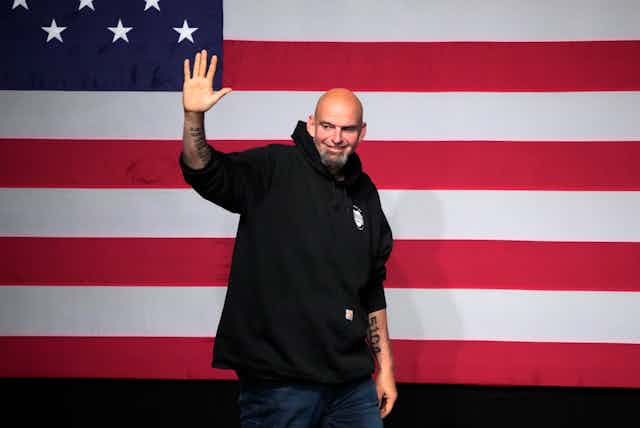On average, the US president’s political party loses 28 seats in the House of Representatives and four Senate seats in their first midterm elections. While votes continue to be tallied, early results indicate that President Joe Biden’s Democratic Party has, at the very least, done far better than average.
Unlike Bill Clinton’s first midterm in 1994, or Barack Obama’s first in 2010, early results make clear that these midterm elections were by no means a “shellacking” for Biden’s Democratic Party. This is an all the more remarkable outcome in light of levels of inflation and interest rates that have not been seen in decades. Biden now faces the prospect of a slim Republican majority in the House of Representatives, and a Senate that may even retain Democratic control.
Some may see such a minor change in the electoral makeup as an indication that perhaps Americans aren’t really sure what they want. That would be a mistake.
The nationalisation of political – not policy – battles
“All politics is local” is a refrain in politics around the world. Even without all the results in, the 2022 midterms further underline that in the contemporary United States, local politics are ever more nationalised, while political debates are ever less policy-driven.
While Biden secured historic legislation on infrastructure, climate change and scientific research, Democrats have pleaded for him to be more of a fighter. It’s not clear that Americans care as much about a politician’s policies as they do about a politician’s political battles.
One need only to look at the candidacy of Herschel Walker in Georgia to see such dynamics at play. While he benefits from national name recognition thanks to his collegiate and professional football career, he was dogged by extensive personal controversies and a relatively unknown policy platform.
Nonetheless, nearly half of Georgia voters embraced Walker – not as much for his policy agenda but, in the eyes of some conservatives, because he was a “means to an end”. And in this instance, that end was Republican control of the US Senate.

One of these things is not like the other
The Speaker of the House is not only the second in line to the presidency. The speaker also decides what legislation gets voted on by the 435 members of the House of Representatives, which members occupy which committees, and even the accounting of the House. The transition to a prioritisation of politics over policy is also apparent in the last three Republican Speakers of the House.
Read more: The United States is gearing up for midterm elections. What are they and what's at stake?
John Boehner, a Republican from Ohio, became Speaker of the House in the 2010 midterm elections – the last time a first-term Democratic president lost control of the House. Boehner came to the role with years of experience as chair of the House Republican Conference as well as the House Education Committee.
It was on the latter that he and the late Democratic Senator Ted Kennedy of Massachusetts famously authored the “No Child Left Behind Act” of 2001, which implemented wide-reaching national education reforms during the Bush administration.
Paul Ryan, who became Speaker of the House after Boehner’s retirement in 2015, got the gavel after years as chairman of the House Budget Committee. Seen across party lines as a policy wonk with a fondness for detailed debates about entitlement reforms, Ryan would end up securing the signature piece of legislation for Donald Trump’s term of office: the Tax Cuts and Jobs Act of 2017.
The presumptive new Republican Speaker of the House, Kevin McCarthy, comes to the role with no committee membership or signature legislative accomplishments, particularly of any bipartisan variety. Perhaps the most significant accomplishment of McCarthy’s political career so far is the way he has successfully navigated the whims of Trump – the de facto party leader and presumptive 2024 presidential candidate.
Debates about the size and scope of government on issues like education and taxes no longer dominate the US political discourse. Instead, political debates – at all levels of US society – are increasingly about politics themselves.
What about the 2024 presidential race?
The ultimate political question of the midterm elections has little to do with 2022 but instead 2024. In an effort to clear the field of any other Republican presidential contenders, Trump is expected to announce he is running for president in 2024 as early as next week. His announcement is, however, unlikely to dampen the presidential aspirations of one of the midterm election’s big winners: Florida’s Republican governor Ron DeSantis.

DeSantis’ nearly 20-point victory over former Florida governor Charlie Crist only increased a sizeable national profile for a politician already beating Trump in some polls of Republican voters.
DeSantis’ resounding win was all the more remarkable given his increased win margin over what Trump won in 2020, as well as what DeSantis won in 2018. In Miami-Dade county, for example, DeSantis improved on his 2018 election win by 16 points.
Unsurprisingly, Trump recently decided to make public long-simmering tensions between the two Florida residents, calling the governor “DeSanctimonious” while indicating he could publicly disclose unsavoury information about DeSantis.
We are a long way away from knowing the 2024 presidential candidates. After all, Trump took the escalator to announce his candidacy for president in June 2015 – more than half a year after the 2014 midterm elections.
Yet with nearly 200 politicians who questioned the 2020 election winning their midterm races, and ever higher numbers of Americans concerned about their democracy, we already know for sure the 2024 race will be more eventful than average.

